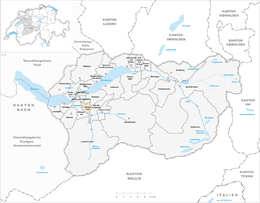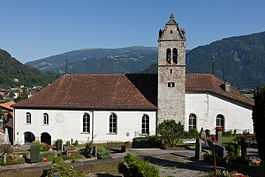Gsteigwiler
| Gsteigwiler | ||
|---|---|---|
|
Gsteig bei Interlaken village church | ||
| ||
 Gsteigwiler | ||
|
Location of Gsteigwiler  | ||
| Coordinates: 46°39′N 7°52′E / 46.650°N 7.867°ECoordinates: 46°39′N 7°52′E / 46.650°N 7.867°E | ||
| Country | Switzerland | |
| Canton | Bern | |
| District | Interlaken-Oberhasli | |
| Government | ||
| • Mayor | Bernhard Seiler | |
| Area[1] | ||
| • Total | 7.02 km2 (2.71 sq mi) | |
| Elevation | 645 m (2,116 ft) | |
| Population (Dec 2013[2]) | ||
| • Total | 422 | |
| • Density | 60/km2 (160/sq mi) | |
| Postal code | 3814 | |
| SFOS number | 0577 | |
| Surrounded by | Matten bei Interlaken, Bönigen, Gündlischwand and Wilderswil | |
| Website |
www SFSO statistics | |
Gsteigwiler is a municipality in the Interlaken-Oberhasli administrative district in the canton of Bern in Switzerland.
History
Gsteigwiler is first mentioned in 1333 as Wiler.[3]
The village first appears during the Middle Ages when it was owned by local nobles. In 1310 they donated the village to Interlaken Abbey. It remained in the hands of the Abbey until Bern accepted the Protestant Reformation and secularized the Abbey in 1528. Under Bernese rule it became part of the new bailiwick of Interlaken and remained part of the district of Interlaken until it was dissolved in 2009.[3]
The village remained isolated until the Wilderswil station of the Bernese Oberland Railway was built in 1890. Two years later a rack railway was built from the village to Breitlauenen in the Schynige Platte mountains.
Today most of the population commutes to Interlaken for work, though there is some tourism in the village.[3]
Geography
Gsteigwiler has an area of 7.02 km2 (2.71 sq mi).[1] Of this area, 1.58 km2 (0.61 sq mi) or 22.5% is used for agricultural purposes, while 4.57 km2 (1.76 sq mi) or 65.1% is forested. Of the rest of the land, 0.31 km2 (0.12 sq mi) or 4.4% is settled (buildings or roads), 0.1 km2 (25 acres) or 1.4% is either rivers or lakes and 0.47 km2 (0.18 sq mi) or 6.7% is unproductive land.[4]
Of the built up area, housing and buildings made up 2.3% and transportation infrastructure made up 2.0%. Out of the forested land, 59.0% of the total land area is heavily forested and 5.4% is covered with orchards or small clusters of trees. Of the agricultural land, 10.3% is pastures and 11.7% is used for alpine pastures. All the water in the municipality is flowing water. Of the unproductive areas, 2.4% is unproductive vegetation and 4.3% is too rocky for vegetation.[4]
The original name of the town was "Wiler," which goes back to the Old High German wilari (small town). The prefix Gsteig- was added to distinguish it from the many other Wilers, and means "abrupt mountain slope that one cannot drive a wagon on."
The municipality contains the church of the village Gsteig bei Interlaken, which is the center of the parish for this and eight nearby municipalities, one of the largest parishes in the canton. The church is noted for its murals.
The municipality is located on the western slope of the Schynige Platte mountain region and on the right bank of the Lütschine river.
On 31 December 2009 Amtsbezirk Interlaken, the municipality's former district, was dissolved. On the following day, 1 January 2010, it joined the newly created Verwaltungskreis Interlaken-Oberhasli.[5]
Coat of arms
The blazon of the municipal coat of arms is Argent a Semi Chamois rampant couped Sable.[6]
Demographics
Gsteigwiler has a population (as of December 2013) of 422.[2] As of 2010, 8.2% of the population are resident foreign nationals.[7] Over the last 10 years (2000-2010) the population has changed at a rate of -5.6%. Migration accounted for -5.6%, while births and deaths accounted for -0.4%.[8]
Most of the population (as of 2000) speaks German (462 or 96.9%) as their first language, Portuguese is the second most common (4 or 0.8%) and French is the third (3 or 0.6%). There is 1 person who speaks Italian and 1 person who speaks Romansh.[9]
As of 2008, the population was 52.9% male and 47.1% female. The population was made up of 206 Swiss men (48.5% of the population) and 19 (4.5%) non-Swiss men. There were 184 Swiss women (43.3%) and 16 (3.8%) non-Swiss women.[7] Of the population in the municipality, 160 or about 33.5% were born in Gsteigwiler and lived there in 2000. There were 190 or 39.8% who were born in the same canton, while 89 or 18.7% were born somewhere else in Switzerland, and 28 or 5.9% were born outside of Switzerland.[9]
As of 2010, children and teenagers (0-19 years old) make up 20% of the population, while adults (20-64 years old) make up 64% and seniors (over 64 years old) make up 16%.[8]
As of 2000, there were 247 people who were single and never married in the municipality. There were 190 married individuals, 25 widows or widowers and 15 individuals who are divorced.[9]
As of 2000, there were 58 households that consist of only one person and 21 households with five or more people. In 2000, a total of 160 apartments (71.1% of the total) were permanently occupied, while 46 apartments (20.4%) were seasonally occupied and 19 apartments (8.4%) were empty.[10] The vacancy rate for the municipality, in 2011, was 0.82%.
The historical population is given in the following chart:[3][11]

Sights
The entire village of Gsteig bei Interlaken is designated as part of the Inventory of Swiss Heritage Sites[12]
Politics
In the 2011 federal election the most popular party was the Swiss People's Party (SVP) which received 33.4% of the vote. The next three most popular parties were the Conservative Democratic Party (BDP) (18.6%), the Social Democratic Party (SP) (13.2%) and the Green Party (9.5%). In the federal election, a total of 161 votes were cast, and the voter turnout was 46.7%.[13]
Economy
As of 2011, Gsteigwiler had an unemployment rate of 1.86%. As of 2008, there were a total of 174 people employed in the municipality. Of these, there were 32 people employed in the primary economic sector and about 12 businesses involved in this sector. 9 people were employed in the secondary sector and there were 6 businesses in this sector. 133 people were employed in the tertiary sector, with 13 businesses in this sector.[8] There were 212 residents of the municipality who were employed in some capacity, of which females made up 39.2% of the workforce.
In 2008 there were a total of 123 full-time equivalent jobs. The number of jobs in the primary sector was 15, of which 14 were in agriculture and 1 was in forestry or lumber production. The number of jobs in the secondary sector was 8 of which 5 or (62.5%) were in manufacturing and 3 (37.5%) were in construction. The number of jobs in the tertiary sector was 100. In the tertiary sector; 19 or 19.0% were in the movement and storage of goods, 6 or 6.0% were in a hotel or restaurant, 4 or 4.0% were in education and 55 or 55.0% were in health care.[14]
In 2000, there were 50 workers who commuted into the municipality and 160 workers who commuted away. The municipality is a net exporter of workers, with about 3.2 workers leaving the municipality for every one entering.[15] Of the working population, 17.5% used public transportation to get to work, and 50% used a private car.[8]
Religion

From the 2000 census, 40 or 8.4% were Roman Catholic, while 328 or 68.8% belonged to the Swiss Reformed Church. Of the rest of the population, there were 113 individuals (or about 23.69% of the population) who belonged to another Christian church. There were 5 (or about 1.05% of the population) who were Islamic. There was 1 person who was Buddhist. 36 (or about 7.55% of the population) belonged to no church, are agnostic or atheist, and 7 individuals (or about 1.47% of the population) did not answer the question.[9]
Education
In Gsteigwiler about 184 or (38.6%) of the population have completed non-mandatory upper secondary education, and 35 or (7.3%) have completed additional higher education (either university or a Fachhochschule). Of the 35 who completed tertiary schooling, 68.6% were Swiss men, 20.0% were Swiss women.[9]
The Canton of Bern school system provides one year of non-obligatory Kindergarten, followed by six years of Primary school. This is followed by three years of obligatory lower Secondary school where the students are separated according to ability and aptitude. Following the lower Secondary students may attend additional schooling or they may enter an apprenticeship.[16]
During the 2010-11 school year, there were a total of 90 students attending classes in Gsteigwiler. There was one kindergarten class with a total of 8 students in the municipality. Of the kindergarten students, 12.5% were permanent or temporary residents of Switzerland (not citizens). The municipality had one primary class and 21 students. Of the primary students, 9.5% have a different mother language than the classroom language. During the same year, there was one lower secondary class with a total of 8 students. 12.5% have a different mother language than the classroom language. The remainder of the students attend a private or special school.[17]
As of 2000, there were 5 students in Gsteigwiler who came from another municipality, while 33 residents attended schools outside the municipality.[15]
Transportation

The Interlaken-Zweilütschinen railway line goes along the valley, but the nearest station is in Wilderswil. In Gsteigwiler there is an interstation for the tourist road of the Schynige Platte.
Further reading
- Heinz Häsler: Gsteigwiler: Bilder einer kleinen Gemeinde. Gsteigwiler, 1995, ISBN 3-85884-052-1
References
- ↑ 1.0 1.1 Arealstatistik Standard - Gemeindedaten nach 4 Hauptbereichen
- ↑ 2.0 2.1 Swiss Federal Statistical Office - STAT-TAB, online database – Datenwürfel für Thema 01.2 - Bevölkerungsstand und -bewegung (German) accessed 18 August 2014
- ↑ 3.0 3.1 3.2 3.3 Gsteigwiler in German, French and Italian in the online Historical Dictionary of Switzerland.
- ↑ 4.0 4.1 Swiss Federal Statistical Office-Land Use Statistics 2009 data (German) accessed 25 March 2010
- ↑ Nomenklaturen – Amtliches Gemeindeverzeichnis der Schweiz (German) accessed 4 April 2011
- ↑ Flags of the World.com accessed 19-March-2013
- ↑ 7.0 7.1 Statistical office of the Canton of Bern (German) accessed 4 January 2012
- ↑ 8.0 8.1 8.2 8.3 Swiss Federal Statistical Office accessed 19 March 2013
- ↑ 9.0 9.1 9.2 9.3 9.4 STAT-TAB Datenwürfel für Thema 40.3 - 2000 (German) accessed 2 February 2011
- ↑ Swiss Federal Statistical Office STAT-TAB - Datenwürfel für Thema 09.2 - Gebäude und Wohnungen (German) accessed 28 January 2011
- ↑ Swiss Federal Statistical Office STAT-TAB Bevölkerungsentwicklung nach Region, 1850-2000 (German) accessed 29 January 2011
- ↑ "Kantonsliste A-Objekte". KGS Inventar (in German). Federal Office of Civil Protection. 2009. Retrieved 25 April 2011.
- ↑ Swiss Federal Statistical Office 2011 Election (German) accessed 8 May 2012
- ↑ Swiss Federal Statistical Office STAT-TAB Betriebszählung: Arbeitsstätten nach Gemeinde und NOGA 2008 (Abschnitte), Sektoren 1-3 (German) accessed 28 January 2011
- ↑ 15.0 15.1 Swiss Federal Statistical Office - Statweb (German) accessed 24 June 2010
- ↑ EDK/CDIP/IDES (2010). Kantonale Schulstrukturen in der Schweiz und im Fürstentum Liechtenstein / Structures Scolaires Cantonales en Suisse et Dans la Principauté du Liechtenstein (PDF) (Report). Retrieved 24 June 2010.
- ↑ Schuljahr 2010/11 pdf document(German) accessed 4 January 2012
External links
| Wikimedia Commons has media related to Gsteigwiler. |
- Gsteigwiler in German, French and Italian in the online Historical Dictionary of Switzerland.

